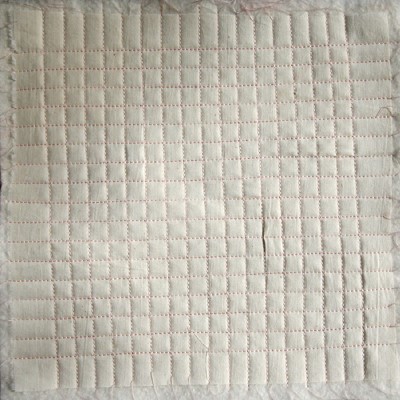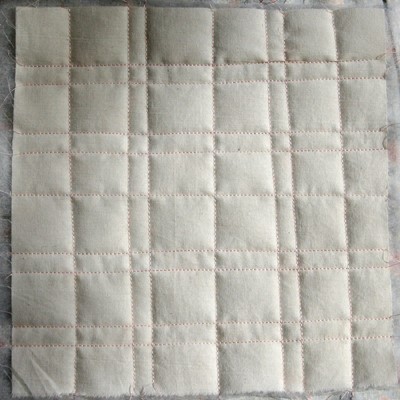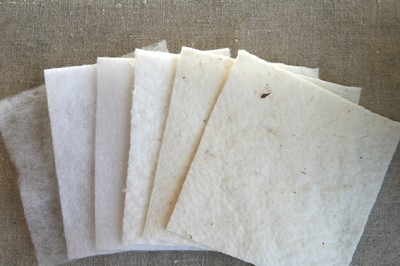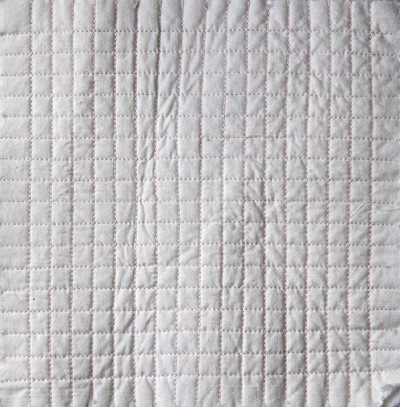Once you have pieced a beautiful patchwork top, the next step in the quilt making process requires batting. (Or perhaps it is called wadding where you live?) Batting is simply the stuff in the middle of your quilt – the layer between the front and the back that gives your quilt dimension and warmth.

Batting Guide from Amy
Since quilts have this extra layer, they require quilting – that is, stitching, (plain or fancy, by machine or by hand) to hold the layers together. There are some choices when it comes to batting. Here is how I (a self-proclaimed non-expert) understand them:
Types of Batting Cotton
- 100% cotton battings are soft, usually supple (drapable), and usually thin (low-loft) but it seems these days they can be found with many variations.
- Cotton breathes – so your quilt will too.
- If not preshrunk, cotton tends to shrink. When you wash your quilt for the first time, the batting will shrink and create that wrinkly, quilty look that you either love or hate. (I love.)
Since normal cotton fibers will tend to shift around in your quilt over time if not properly anchored with stitches, the batting manufacturers tell you that your quilting “lines” must be close together (usually 2-3” maximum) to prevent this bunching/shifting. There are manufacturers of new types of cotton batts that claim otherwise and say you can quilt them further apart (up to 8”.) I haven’t had the guts to test their word yet.

Cotton Blends
- There are many, many different types of batting that are part cotton, part synthetic (nylon, polyester, mircofiber, polypropylene) in a variety of ratios 87.5/12.5, 80/20 50/50…)
Because of these added synthetic fibers, these battings require less quilting to be stable. This is a plus for people like me for whom quilting is not easy nor the favorite step in the process.
The lofts (thickness), weights/drapes, and shrinkage properties of these products vary and it may take some experimentation to find the one that suits your purposes. There are some that I love and some that I cannot stand the feel of.
The batting I have worked most with 87.5% cotton, 12.5% polypropylene. It is easy to find at the local craft stores and can be bought by the yard on big rolls when it is on sale or with a coupon. (And by the way, I have no interest in giving this recommendation!) I have found it to be a very nice product for my purposes.
Synthetics
- Synthetic battings (frequently polyester) also vary in thickness though in general they run from medium to high loft (on the thicker side.)
- They are generally lighter in weight so they will produce a lighter quilt that doesn’t drape as well.
If you plan to tie your quilt, instead of quilting it, it is often recommended that you use a synthetic batting because they require less anchoring than cotton battings. High loft (very puffy) polyester batting is OK for tying but not recommended for quilting (especially hand quilting.) But if you ever look at a quilts and crafts from the 1970s you will see this “rule” was meant to be broken!
Some synthetic battings (especially the high-loft ones) have loose fibers that tend to work their way through the layers of your quilt (known as bearding). This is especially evident if your fabric is dark colored. Some synthetic battings come colored black for this reason.
In my opinion, most synthetic battings that I’ve tried are slipperier than cotton battings so they tend to shift around more as you are quilting. If I use them, I try to baste more heavily to prevent some of this.
Because of their flammability, I personally don’t like the idea of using polyester batting (or fabric for that matter) for quilts that people (babies and kids especially) will sleep under.

Wool/Silk
- I have not worked with wool or silk bats so I have no direct knowledge to share, but I know they are out there and I bet they are nice to work with.
- They are more expensive, as you might have guessed.
Cotton Flannel
- Flannel makes an interesting, very thin batting for quilted projects like bedspreads or tablecloths.
- Since it is so thin, the quilt design doesn’t stand out, so don’t waste your time doing anything fancy.

Other (That Catchall)
- Some people use fleece for their battings. I find it too stretchy/slippy to use and definitely thick for my climate. I have tried to use fleece for the back of a few of my quilts and quilt the top directly to the fleece with no additional batting.
- This has produced, shall we say, mixed results.
- Fusible battings can be ironed to your quilt top, eliminating the need for basting. I haven’t used these products myself but have seen them used in small, machine quilted projects.
- 100% cotton battings are available now in organic varieties.
- You can do like the pioneers and struggling quilt makers of times past have done and use whatever extra “stuff” you have as batting. If you piece things (old cloth diapers? washcloths? etc.) to use in your quilt you will just have to live with the bunches and creases and irregularities but that is part of the charm of make-do quilts – and definitely in line with the history of quilt making! Hmmm, while you are at it, you could card some cotton that was leftover in the fields. OK, now I’m getting off track…

Working with Batting
- Batting can be bought folded or rolled in packages or by the yard.
- I prefer to buy batting by the yard because I can cut off just what I need for each quilt and have less waste.
- If in packages, batting is generally sold in standard bed-sized quantities – crib, twin, full, queen, king. You will need your batting to be a couple inches bigger than your quilt top on all sides.
- Some battings can be pre-washed to eliminate shrinkage. Check your manufacturer’s recommendations. Some people like flat quilts with no wrinkles and puckers. I am of the opposite school and so never pre-wash my battings.
- You can drape or lay your batting flat overnight to let the fold/wrinkles relax before using it. Some battings can be thrown in the clothes dryer and fluffed before use to remove wrinkles. Some battings can even be ironed carefully.
- Check the manufacturer’s information to see if your batting has a top/bottom side or grain lines (direction the fibers run). For less possibility of distortion you should make your batting’s grain lines run in the same direction as your backing fabric’s grain line.
- Remember to check the quilting requirements for the batting you will use and plan your quilting design accordingly. If you exceed the recommended maximum distance between quilting lines your batting could shift/bunch/tear inside your quilt over time.
- You can piece large scraps of batting together as a way to re-use all those cut off ends. I think this is a nice option for scrap quilts especially. You can sew the pieces of batting together by machine but you’ll end up with a bulky seam in your quilt. You can just butt them together without sewing but you might end up with a gap. You can try hand sewing the pieces using a long/wide machine zigzag stitch for the same effect.
